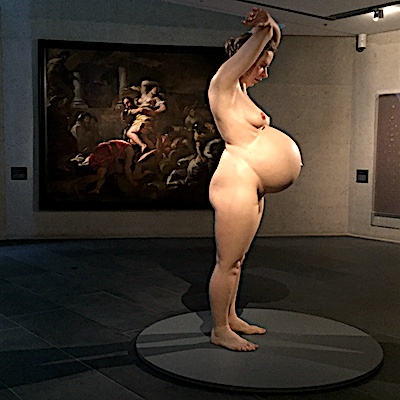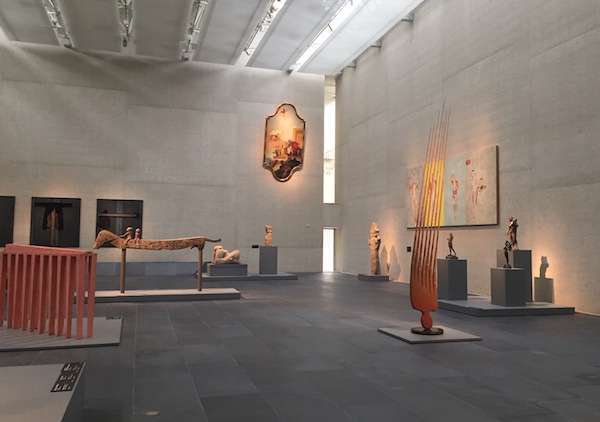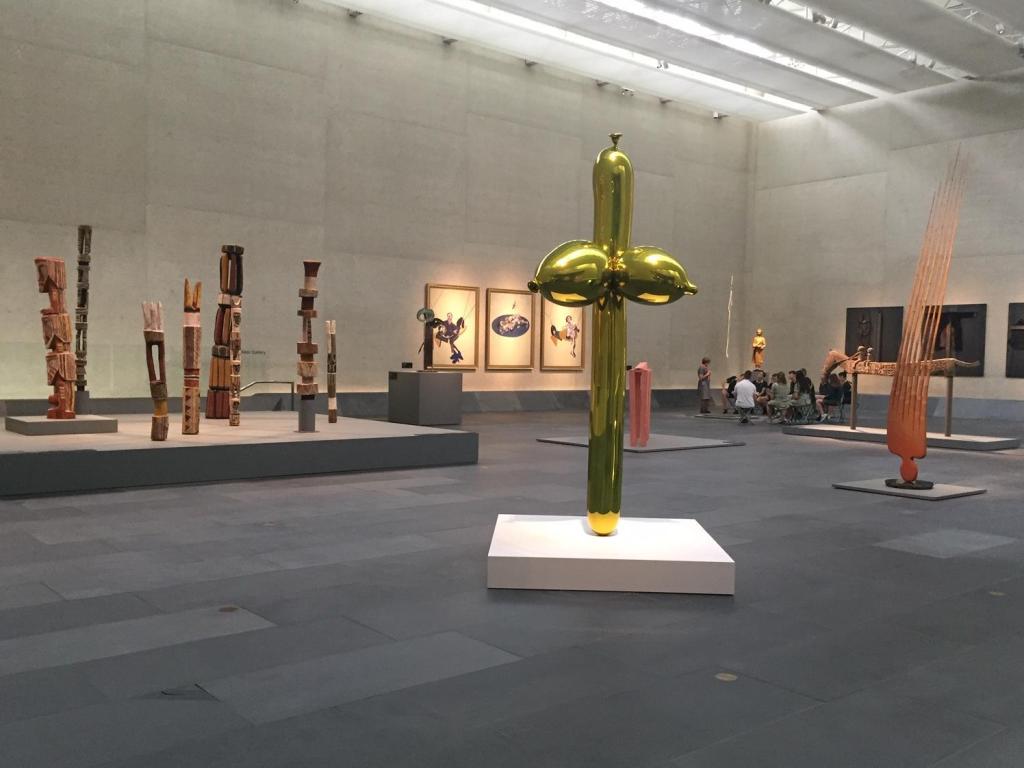Installation view Bodies of art: Human form from the National Collection, National Gallery of Australia (2019); Photo Artshub.
Recently, I was at the National Gallery of Australia (NGA) for the unveiling of their newly acquired Yayoi Kusama infinity room, The Spirits of the Pumpkins Descended into the Heavens (2015). However, it was another exhibition, also unveiled that week, which caught my attention as a signal of an institution on the cusp of great change.
It was NGA’s Director Nick Mitzevich first “stamp” on the national institution with a new collection hang. The location was the double-height lower gallery, which has largely been reserved for large-scale installations and object-base work. It is the first time that paintings have been shown in this space for a very long time.
Bodies of art: Human form from the National Collection opened after just 108 days into Mitzevich’s tenure as director. Mitzevich worked at lightening speed to not only get an astute read on the collection to then curate a show, but also to boldly interject into the stitched-up program.
It would have been an easier, more logical choice, to put the new Yayoi Kusama acquisition in this space – especially given the expected foot traffic – but Mitzevich has chosen to embed it deep in the upstairs galleries, and adjacent to another significant earlier acquisition by the gallery, David Hockney’s A Bigger Grand Canyon (1998, acquired 1999).
The Kusama was unveiled just days after the record sale of Hockney’s painting Portrait of an Artist (Pool with Two Figures) (1972), sold in November by Christies auction house in New York for $US90.3M (AUD$124.8M), and making Hockney the ‘the most highly valued living artist’.
The pairing perhaps reiterates the importance of bold collecting by the institution; and when considered as a trifecta along with Mitzevich’s first acquisition, Francesco (2017) by Swiss artist Urs Fischer to be unveiled in March, these start to look like very deliberate moves.
So why then, was this gesture to turn the sculpture galleries over to painting in a Mitzevich signature show, so important and so quickly?
The answer is perhaps found in the theme of this exhibition – humanity.
In a contemporary world plagued by trauma and crisis, Mitzevich draws an equalizing thread across this show and one that we can all connect with through human form. All styles and genres are represented here – it breathes the brand of inclusivity.
The journey into this exhibition, however, is not an exclusive narrative of beauty. Visitors enter through Annette Messager’s Penetration (1993-94) – a hanging forest of 101 hand-sewn anatomical organs that literally walks us through the human body – to then arrive at Ron Mueck’s monumental, hyperrealist sculpture Pregnant woman 2002 facing you.

Juxtaposition and sight lines are key in this exhibition; here Ron Mueck’s Pregnant woman 2002 with Luca Giordano’s The rape of the Sabine women (c1672) in the background; photo ArtsHub.
It’s a read on what the body is – its human form, its politics, its passion and its foibles is played out around the room through the photographs of Bill Brandt, Bill Henson, Cindy Sherman’s confronting Untitled #255 (1992) from her Sex pictures using mannequins and prosthetic body parts, to Andres Serrano’s Bloodstream (1987) and Julie Rrap’s Puberty (1984).
There is nothing shy in this gallery.
It is only appropriate then, to be ushered into the larger gallery space by Jeff Koon’s Balloon Venus Dolni Vestonice (pictured top) – a golden phallus rendered on the party-trick of tied balloons. It is another globally significant work recently joining the gallery on long-term loan.
Few institutions can say that they have hung the work of Koons alongside Peter Paul Ruben – Self-portrait (1623) – and a field of Tutini mortuary poles by the Tiwi people. And while one might ponder the veracity of the conversation they offer when juxtaposed, you also have to champion the eclecticism of this hang – it’s fresh, brave, slightly schizophrenic and most definitely kooky.
It is through such juxtapositions that Mitzevich has given us a cue to be playful in this exhibition – to not take body politics so seriously but rather celebrate the body in all its historical nuances.
There is a strong play of verticals across the exhibition, which one imagines was deliberate given the double height of the space, but it also creates great texture across this exhibition. Too often when working with large spaces, the energy becomes stifled by the need to “fill” the space.
One takes a walk through art history punctuated by these verticals: from Tiwi poles to Louise Bourgeois’ C.O.Y.O.T.E (1941-48); from Koons’s phallus to Hossein Valamanesh’s Falling (1990), an inverted comb-like figure in bamboo and steel, which has a great conversation with Giulio Paolinin’s angel, Aria (air) (1983), which draws the eye upwards.

Installation view Bodies of art: Human form from the National Collection, National Gallery of Australia (2019); Photo Artshub.
Carrying on that play of celestial elevation, Mitzevich has also placed several works high on the walls (not great for viewing detail but great for impact) – Giambattista Tiepolo’s altarpiece Marriage allegory (c.1737) and a suite of four works by Francesco Clement from 1981.
Unlike blockbuster exhibitions that roll out European and American Masterpieces as signature works to be revered, there appears to be no hierarchy in this exhibition. It is a great calling card for what is to come under Mitzevich’s directorship.
For example, we see the important bark by Yirawala, Maralaitj, Earth Mother (1973) – capturing the bold moment of birth – with Lucien Freud’s fleshy painting, After Cezanne (1999-2000) and Wlliam de Kooning’s Woman V (1952-53), which challenges traditional depictions of women through art history.
You find a quintessential Baroque work, like Lua Giordano’s The rape of the Sabine women (c.1672) weighted with equal significant for contemporary audiences as Jannis Kounellis’ three steel panels with clothes, Senza Titolo (untitled) 1970 and a sculpture by the Thai people carrying alms.
While the title of this show is not so “fresh”, and if anything is a bit convoluted, the hang of the artworks themselves certainly perks a recalibration on our take of the body through art history.
Simply, Bodies of art: Human form from the National Collection traverses gender, genre and history, putting them together in a visual mosh pit set on spin. This collection show is definitely worth a look.
Rating: 5 stars ★★★★★
Bodies of Art: Human form from the national collection
National Gallery of Australia
1 December 2018 – 2019 ongoing
nga.gov.au/bodiesofart/





